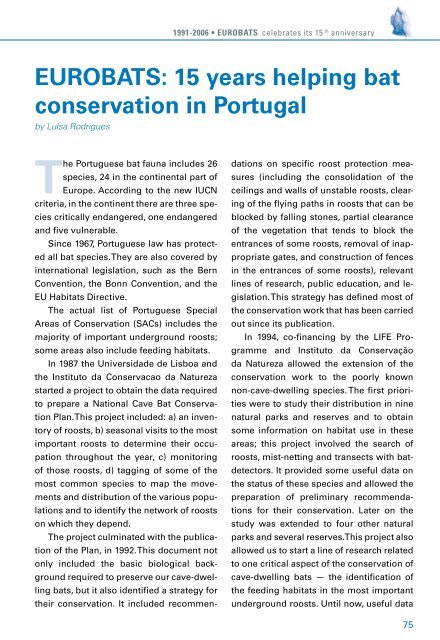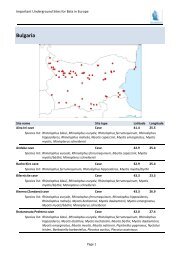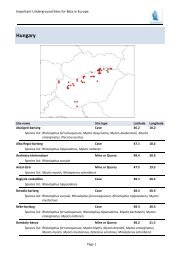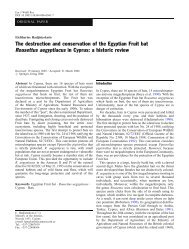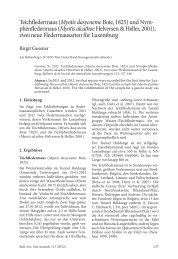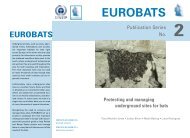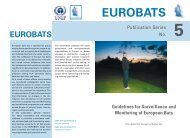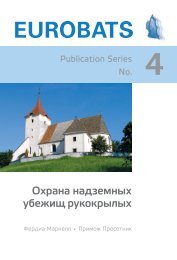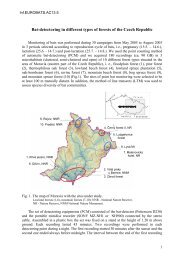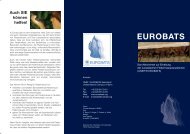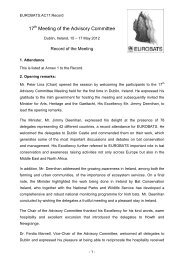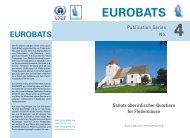1991 - 2006. EUROBATS celebrates its 15th anniversary
1991 - 2006. EUROBATS celebrates its 15th anniversary
1991 - 2006. EUROBATS celebrates its 15th anniversary
Create successful ePaper yourself
Turn your PDF publications into a flip-book with our unique Google optimized e-Paper software.
<strong>1991</strong>-2006 • <strong>EUROBATS</strong> <strong>celebrates</strong> <strong>its</strong> 15 th <strong>anniversary</strong><br />
<strong>EUROBATS</strong>: 15 years helping bat<br />
conservation in Portugal<br />
by Luísa Rodrigues<br />
The Portuguese bat fauna includes 26<br />
species, 24 in the continental part of<br />
Europe. According to the new IUCN<br />
criteria, in the continent there are three spe-<br />
cies critically endangered, one endangered<br />
and five vulnerable.<br />
Since 1967, Portuguese law has protect-<br />
ed all bat species. They are also covered by<br />
international legislation, such as the Bern<br />
Convention, the Bonn Convention, and the<br />
EU Habitats Directive.<br />
The actual list of Portuguese Special<br />
Areas of Conservation (SACs) includes the<br />
majority of important underground roosts;<br />
some areas also include feeding habitats.<br />
In 1987 the Universidade de Lisboa and<br />
the Instituto da Conservacao da Natureza<br />
started a project to obtain the data required<br />
to prepare a National Cave Bat Conservation<br />
Plan. This project included: a) an inventory<br />
of roosts, b) seasonal vis<strong>its</strong> to the most<br />
important roosts to determine their occupation<br />
throughout the year, c) monitoring<br />
of those roosts, d) tagging of some of the<br />
most common species to map the movements<br />
and distribution of the various populations<br />
and to identify the network of roosts<br />
on which they depend.<br />
The project culminated with the publication<br />
of the Plan, in 1992. This document not<br />
only included the basic biological background<br />
required to preserve our cave-dwelling<br />
bats, but it also identified a strategy for<br />
their conservation. It included recommen-<br />
dations on specific roost protection measures<br />
(including the consolidation of the<br />
ceilings and walls of unstable roosts, clearing<br />
of the flying paths in roosts that can be<br />
blocked by falling stones, partial clearance<br />
of the vegetation that tends to block the<br />
entrances of some roosts, removal of inappropriate<br />
gates, and construction of fences<br />
in the entrances of some roosts), relevant<br />
lines of research, public education, and legislation.<br />
This strategy has defined most of<br />
the conservation work that has been carried<br />
out since <strong>its</strong> publication.<br />
In 1994, co-financing by the LIFE Programme<br />
and Instituto da Conservação<br />
da Natureza allowed the extension of the<br />
conservation work to the poorly known<br />
non-cave-dwelling species. The first priorities<br />
were to study their distribution in nine<br />
natural parks and reserves and to obtain<br />
some information on habitat use in these<br />
areas; this project involved the search of<br />
roosts, mist-netting and transects with batdetectors.<br />
It provided some useful data on<br />
the status of these species and allowed the<br />
preparation of preliminary recommendations<br />
for their conservation. Later on the<br />
study was extended to four other natural<br />
parks and several reserves. This project also<br />
allowed us to start a line of research related<br />
to one critical aspect of the conservation of<br />
cave-dwelling bats — the identification of<br />
the feeding habitats in the most important<br />
underground roosts. Until now, useful data<br />
7


